Churchill AVRE on:
[Wikipedia]
[Google]
[Amazon]
This is a list of specialist variants of the British
 Proposed by a Canadian engineer as a result of experience from the
Proposed by a Canadian engineer as a result of experience from the
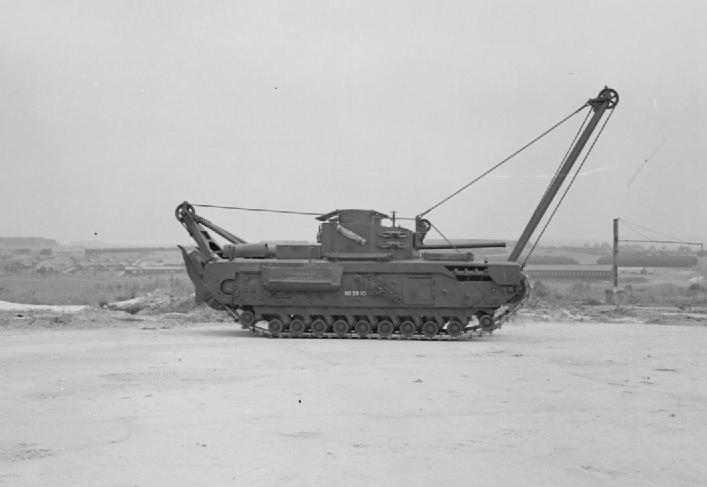 Two marks of
Two marks of
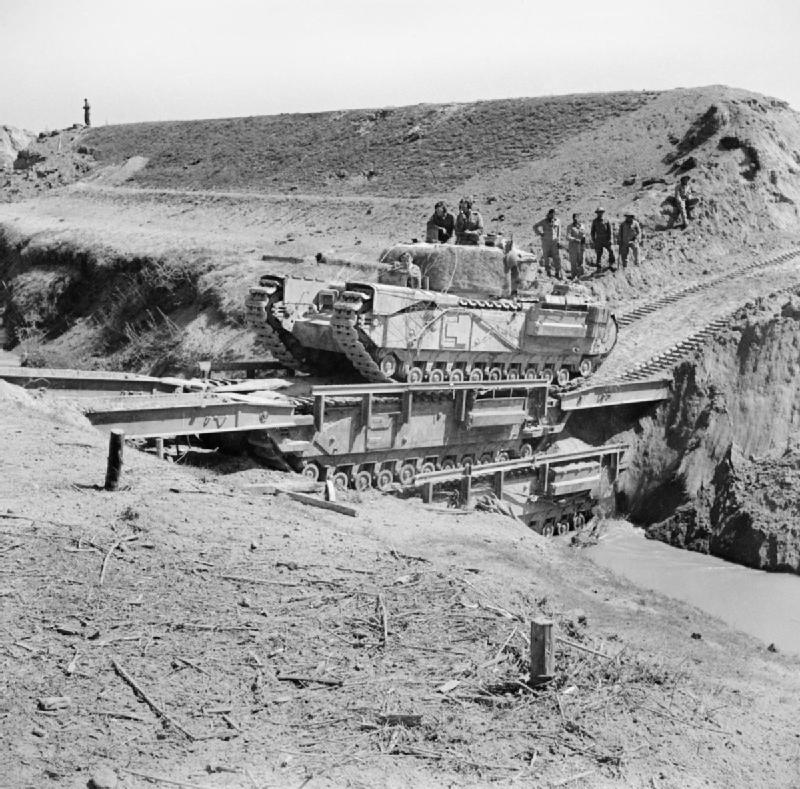
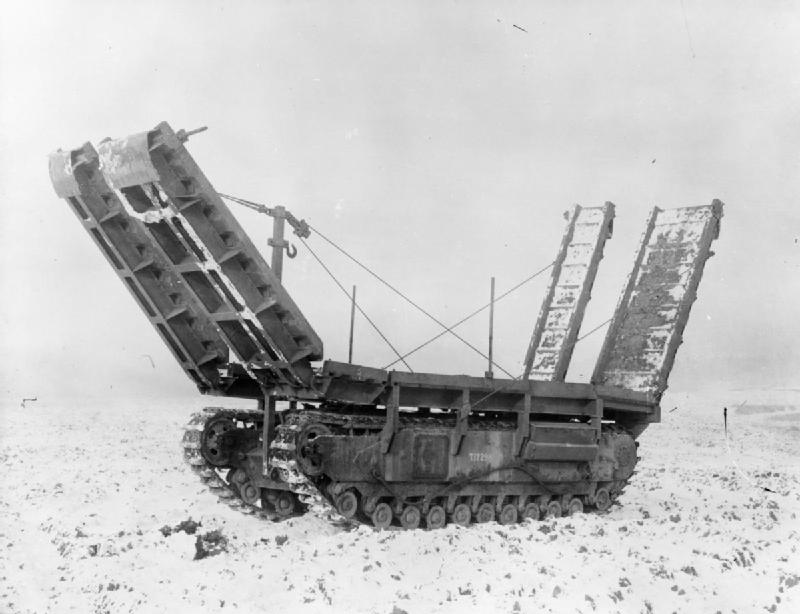 The Armoured Ramp Carrier (ARK) was a turretless Churchill with ramps at either end and trackways along the body to form a mobile bridge. Fifty of these were built on Mark II and Mark IV Churchills. The Link Ark or Twin Ark was two ARKs used side by side to give a wide crossing. The ramps on these were folding types giving a longer, , crossing. The Twin-ARK was used for the post-war Conqueror heavy tank.
Ark Mk II had a wider, instead of the usual , trackway on the left side so narrower vehicles could also use the ARK. These were conversions of the Ark Mark I in mid-1944. The "Italian Pattern" Ark Mk II (initially called "Octopus") was produced in Italy using US ramps on Churchill Mk III chassis and did not have trackways on the tank itself (vehicles drove on the tank's tracks).Chamberlain & Ellis (1969) p70-71
"Lakeman Ark" was an experimental design for attacking very high obstacles. It was a turreted Churchill with the trackways built above the height of the turret, and long ramps at the rear.Chamberlain & Ellis (1969) p73
The Armoured Ramp Carrier (ARK) was a turretless Churchill with ramps at either end and trackways along the body to form a mobile bridge. Fifty of these were built on Mark II and Mark IV Churchills. The Link Ark or Twin Ark was two ARKs used side by side to give a wide crossing. The ramps on these were folding types giving a longer, , crossing. The Twin-ARK was used for the post-war Conqueror heavy tank.
Ark Mk II had a wider, instead of the usual , trackway on the left side so narrower vehicles could also use the ARK. These were conversions of the Ark Mark I in mid-1944. The "Italian Pattern" Ark Mk II (initially called "Octopus") was produced in Italy using US ramps on Churchill Mk III chassis and did not have trackways on the tank itself (vehicles drove on the tank's tracks).Chamberlain & Ellis (1969) p70-71
"Lakeman Ark" was an experimental design for attacking very high obstacles. It was a turreted Churchill with the trackways built above the height of the turret, and long ramps at the rear.Chamberlain & Ellis (1969) p73
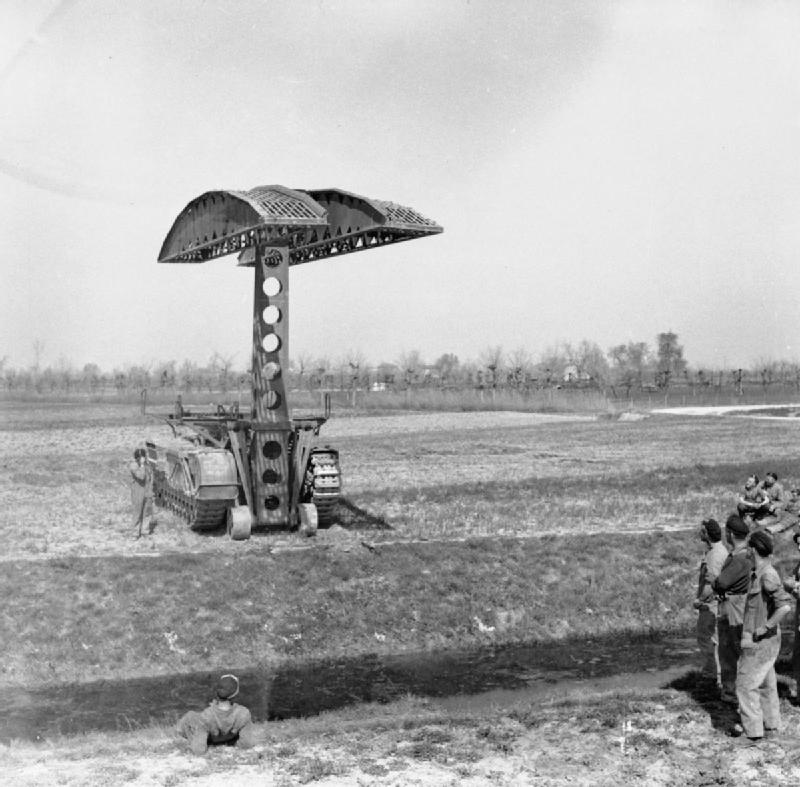 The British already had experience of bridge-laying tanks with the
The British already had experience of bridge-laying tanks with the
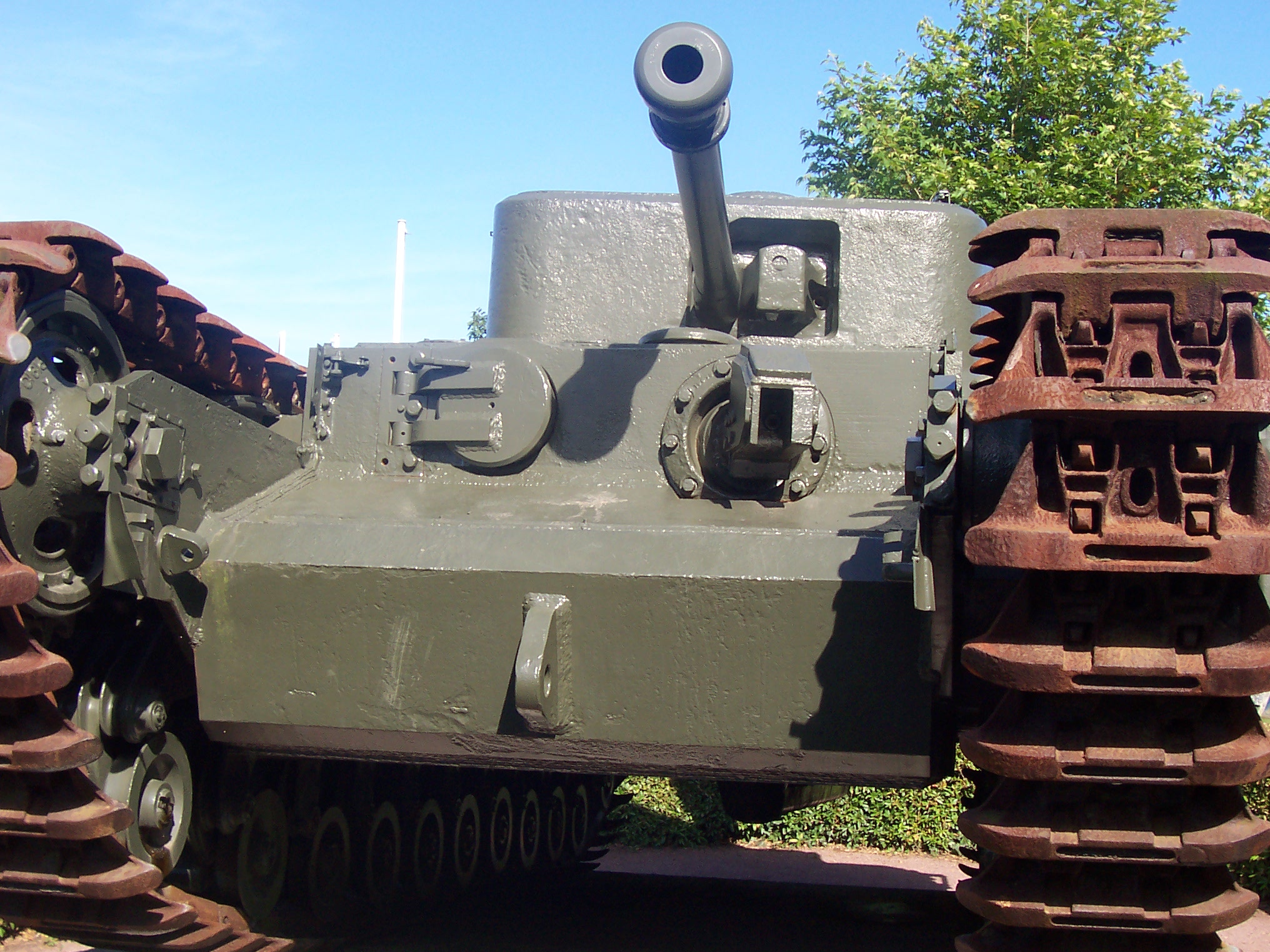 The Churchill Crocodile was a Churchill VII that was converted by replacing the hull machine gun with a flamethrower projector. The fuel, and the compressed gas to drive it, was in an armoured wheeled trailer towed behind. It could fire several one second bursts out to a distance of over 150 yards. The Crocodile was one of "
The Churchill Crocodile was a Churchill VII that was converted by replacing the hull machine gun with a flamethrower projector. The fuel, and the compressed gas to drive it, was in an armoured wheeled trailer towed behind. It could fire several one second bursts out to a distance of over 150 yards. The Crocodile was one of "
 Coming out of a General Staff request in 1941 to investigate fitting high velocity large calibre guns on infantry and
Coming out of a General Staff request in 1941 to investigate fitting high velocity large calibre guns on infantry and
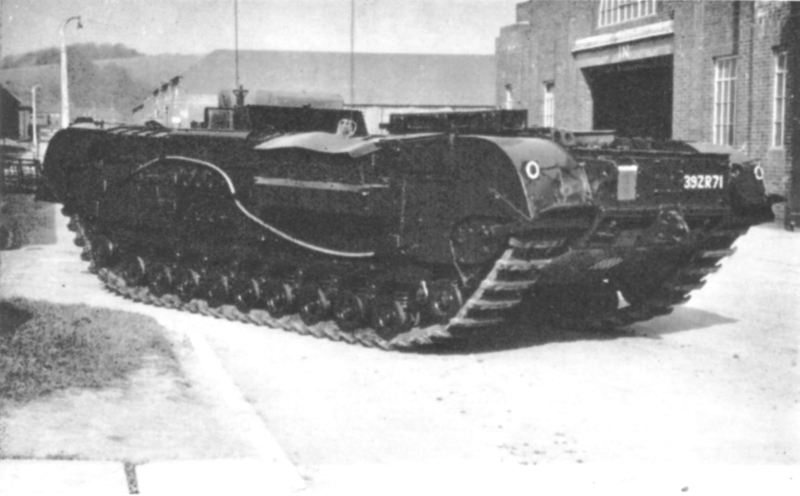 The Churchill Kangaroo was a turretless Churchill hull converted to an
The Churchill Kangaroo was a turretless Churchill hull converted to an
Churchill tank
The Tank, Infantry, Mk IV (A22) Churchill was a British infantry tank used in the Second World War, best known for its heavy armour, large longitudinal chassis with all-around tracks with multiple Bogie#Tracked vehicles, bogies, its ability to ...
.
Churchill Oke
A Churchill Mark II or Mark III with aflamethrower
A flamethrower is a ranged incendiary device designed to project a controllable jet of fire. First deployed by the Byzantine Empire in the 7th century AD, flamethrowers saw use in modern times during World War I, and more widely in World W ...
. Developed for the amphibious raid on Dieppe in 1942, the Oke flamethrowing tank was named after its designer, Major J.M. Oke. The design was basically a Churchill tank fitted with the Ronson flamethrower equipment. A tank containing the flame fuel was fitted at the rear, with a pipe from it leading to the fixed angle mounting on the front hull to the left, leaving the hull machine gun unobstructed. Three (named "Boar", "Beetle" and "Bull") were present in the first wave at Dieppe; they were quickly lost, and abandoned.
Assault Vehicle Royal Engineers
 Proposed by a Canadian engineer as a result of experience from the
Proposed by a Canadian engineer as a result of experience from the Dieppe Raid
Operation Jubilee or the Dieppe Raid (19 August 1942) was a disastrous Allied amphibious attack on the German-occupied port of Dieppe in northern France, during the Second World War. Over 6,050 infantry, predominantly Canadian, supported by a ...
, the Assault Vehicle Royal Engineers (AVRE) was a Churchill Mark III or IV equipped with the "Mortar, Recoiling Spigot, Mark II" (or ''Petard''), a spigot mortar
A mortar today is usually a simple, lightweight, man-portable, muzzle-loaded cannon, consisting of a smooth-bore (although some models use a rifled barrel) metal tube fixed to a base plate (to spread out the recoil) with a lightweight bipod ...
that throws the Bomb Demolition Number 1 ("Flying dustbin") with a 28-pound high-explosive warhead. The Petard, developed by MD1, was designed for the quick levelling of fortifications. The Petard was reloaded by traversing the turret to point front, slightly to the left, with the barrel directly over the co-driver's sliding hatch. The regular two piece co-driver's hatch was plated over, and a small sliding hatch was installed to allow access to the Petard. The Petard barrel would then be 'broken' vertically, and the co-driver would slide open his hatch. The co-driver would then push the projectile into the barrel. The barrel would then be closed, the Petard traversed back down, and the turret rotated back to its original position. The co-driver's hands were briefly exposed during the process.
The AVRE could also be equipped with numerous other attachments, such as the Small Box Girder
The Small Box Girder bridge (SBG) was a small assault bridge that could be used to span gaps of up to 30 feet. It was typically carried on a tank, such as the Churchill Armoured Vehicle Royal Engineers (AVRE), and could be deployed without eng ...
bridge, which was carried at the front of the tank and laid across ditches or narrow rivers up to 30 feet wide, and the Canadian Indestructible Roller Device (CIRD), which was used to protect the tracks of a tank from mines. It could also carry fascine
A fascine (pronounced ) is a rough bundle of wikt:brushwood, brushwood or other material used for strengthening an earthen structure, or making a path across uneven or wet terrain. Typical uses are protecting the banks of streams from erosion (a ...
s, which are large bundles of wood carried on the front of the tank and dropped into trenches to help the Churchill cross over them, devices to place explosive charges against obstacles, and bobbins: massive reels of canvas on drums that were unrolled in front of the Churchill to help it over soft terrain. They were used during the invasion of Normandy
Operation Overlord was the codename for the Battle of Normandy, the Allied operation that launched the successful liberation of German-occupied Western Europe during World War II. The operation was launched on 6 June 1944 ( D-Day) with the ...
to help the Churchill over soft sand, and also served to leave a trackway for following vehicles.
By the time of the invasion of France in June 1944, 180 AVREs had been converted. They were first deployed in Normandy by the 79th Armoured Division
The 79th Armoured Division was a specialist armoured division of the British Army created during the Second World War. The division was created as part of the preparations for the Normandy invasion on 6 June 1944, D-Day.
Major-General Percy ...
on D-Day. They were extremely successful and served until the end of the war. A further 574 followed.Chamberlain & Ellis (1969) p70 While the driver came from the Royal Armoured Corps
The Royal Armoured Corps is the armoured arm of the British Army, that together with the Household Cavalry provides its armour capability, with vehicles such as the Challenger 2 and the Warrior tracked armoured vehicle. It includes most of the Ar ...
, the five other crew were drawn from the Royal Engineers
The Corps of Royal Engineers, usually called the Royal Engineers (RE), and commonly known as the ''Sappers'', is the engineering arm of the British Army. It provides military engineering and other technical support to the British Armed Forces ...
. One of the RE crew was a demolitions NCO sapper
A sapper, also called a combat engineer, is a combatant or soldier who performs a variety of military engineering duties, such as breaching fortifications, demolitions, bridge-building, laying or clearing minefields, preparing field defenses ...
responsible for priming the "Flying dustbin" and who led the crew when they dismounted from the tank to place demolition charges ("Wade" charges).
Other versions that did not see active service were equipped with anti-mine ploughs, mine rollers, or special demolition charges to destroy reinforced concrete walls.
Post-war, new Churchill AVREs were developed on the basis of a modified Churchill Mk VII armed with a breech-loading low velocity 165mm Royal Ordnance L9 demolition gun that fired a HESH round with about of C4 explosive. The name of the AVRE was later changed to "Armoured Vehicle Royal Engineers".
Armoured Recovery Vehicle
 Two marks of
Two marks of armoured recovery vehicle
An armoured recovery vehicle (ARV) is typically a powerful tank or armoured personnel carrier (APC) chassis modified for use during combat for military vehicle recovery (towing) or repair of battle-damaged, stuck, and/or inoperable armoured f ...
were built from the Churchill
Mk I – A turretless Mk I with a jib that could be fitted at front or rear. Production began in early 1942
Mk II – A Churchill Mark III or Mark IV with a fixed turret/superstructure with a dummy gun. It was equipped for recovering other tanks from the battlefield. It mounted a front jib with a 7.5 ton capacity, a rear jib rated for 15 ton and a winch that could pull 25 tons. With just a three-man crew, there was enough room to carry the crew of the tank being recovered. Armament was a single Besa machine gun
The Besa machine gun was a British version of the Czechoslovak ZB-53 air-cooled, belt-fed machine gun (called the TK vz. 37 in the Czechoslovak army"TK" from ''těžký kulomet'' "heavy machine gun"; "vz" from ''vzor'' "Model").
The name ca ...
.
Armoured Ramp Carrier

 The Armoured Ramp Carrier (ARK) was a turretless Churchill with ramps at either end and trackways along the body to form a mobile bridge. Fifty of these were built on Mark II and Mark IV Churchills. The Link Ark or Twin Ark was two ARKs used side by side to give a wide crossing. The ramps on these were folding types giving a longer, , crossing. The Twin-ARK was used for the post-war Conqueror heavy tank.
Ark Mk II had a wider, instead of the usual , trackway on the left side so narrower vehicles could also use the ARK. These were conversions of the Ark Mark I in mid-1944. The "Italian Pattern" Ark Mk II (initially called "Octopus") was produced in Italy using US ramps on Churchill Mk III chassis and did not have trackways on the tank itself (vehicles drove on the tank's tracks).Chamberlain & Ellis (1969) p70-71
"Lakeman Ark" was an experimental design for attacking very high obstacles. It was a turreted Churchill with the trackways built above the height of the turret, and long ramps at the rear.Chamberlain & Ellis (1969) p73
The Armoured Ramp Carrier (ARK) was a turretless Churchill with ramps at either end and trackways along the body to form a mobile bridge. Fifty of these were built on Mark II and Mark IV Churchills. The Link Ark or Twin Ark was two ARKs used side by side to give a wide crossing. The ramps on these were folding types giving a longer, , crossing. The Twin-ARK was used for the post-war Conqueror heavy tank.
Ark Mk II had a wider, instead of the usual , trackway on the left side so narrower vehicles could also use the ARK. These were conversions of the Ark Mark I in mid-1944. The "Italian Pattern" Ark Mk II (initially called "Octopus") was produced in Italy using US ramps on Churchill Mk III chassis and did not have trackways on the tank itself (vehicles drove on the tank's tracks).Chamberlain & Ellis (1969) p70-71
"Lakeman Ark" was an experimental design for attacking very high obstacles. It was a turreted Churchill with the trackways built above the height of the turret, and long ramps at the rear.Chamberlain & Ellis (1969) p73
Bridgelayers
 The British already had experience of bridge-laying tanks with the
The British already had experience of bridge-laying tanks with the Valentine tank
The Tank, Infantry, Mk III, Valentine was an infantry tank produced in the United Kingdom during World War II. More than 8,000 Valentines were produced in eleven marks, plus specialised variants, accounting for about a quarter of wartime Britis ...
and the Covenanter tank
The Cruiser tank Mk V or A13 Mk III Covenanter was a British cruiser tank of the Second World War. The Covenanter was the first cruiser tank design to be given a name. Designed by the London, Midland and Scottish Railway as a better-armoured rep ...
, and began work on a Churchill-based bridge-layer in 1942. The bridge ("Bridge, Tank, 30 ft, No.2 "), which could support a tank of 60 tons or be used by Class 40 wheeled traffic, was carried on top of a turretless Mk III or Mk VI chassis. When the obstacle was reached, an arm (driven by hydraulics in the tank) pivoted at the front of the tank and placed the bridge in position. The Churchill Mk VII was used with the No. 3 bridge from 1945 to 1946.
Bridges could also be deployed by the Churchill. "Skid Bailey" was a bridge formed from Bailey bridge
A Bailey bridge is a type of portable, Prefabrication, pre-fabricated, Truss Bridge, truss bridge. It was developed in 1940–1941 by the British Empire in World War II, British for military use during the World War II, Second World War and saw ...
parts on skids that was moved into position by one or two Churchill AVREs. Usual use was to bridge cratered roads while under fire.
The "Mobile Bailey Bridge" was a complete bridge suitable for class 40 traffic spanning a gap. The bridge itself was long with ramps at either end. This would be assembled at a safe distance from the gap and then pushed to the site by a Churchill AVRE with another aiding by towing from the front; the middle of the bridge was supported by Orolo unpowered tracked roller units. At the site the AVRE pushed the bridge out over the gap and then disconnected itself.Chamberlain & Ellis (1969) p72-73
The "Mobile Brown Bridge" was an improvement on the Mobile Bailey. Named after a Canadian Royal Engineer in Italy, the Bailey bridge was carried on a Churchill which had its turret removed while an AVRE carried and pushed the rear of the bridge. With the first Churchill in position the AVRE would push the bridge out over the gap; an extra 20 ft tail on the bridge acted as a counterweight while the bridge was put in position.
The "Mobile Dalton Bridge", named after an RE officer, was a long Bailey bridge that was carried on an ARK while a second AVRE pushed. The process was the similar to the Brown Bridge. When the ARK reached the near side of the gap, it stopped and the AVRE pushed the bridge (riding on rollers on the top of the ARK) out over the gap. Once the far end of the bridge was on solid ground the AVRE disengaged and the ARK backed out under the bridge.AFV Profile 20
Churchill Crocodile
Hobart's Funnies
Hobart's Funnies is the nickname given to a number of specialist armoured fighting vehicles derived from tanks operated during the Second World War by units of the 79th Armoured Division of the British Army or by specialists from the Royal En ...
" – another vehicle used by the 79th Armoured Division. A working example can still be seen at the Cobbaton Combat Collection in North Devon.
The combination of projector and trailer was produced as a kit that could be fitted to a Churchill; no more than 800 kits were produced.
Gun Carrier, 3-inch, Mk I, Churchill (A22D)
 Coming out of a General Staff request in 1941 to investigate fitting high velocity large calibre guns on infantry and
Coming out of a General Staff request in 1941 to investigate fitting high velocity large calibre guns on infantry and cruiser tank
The cruiser tank (sometimes called cavalry tank or fast tank) was a British tank concept of the interwar period for tanks designed as modernised armoured and mechanised cavalry, as distinguished from infantry tanks. Cruiser tanks were develop ...
s specifically for use against German tanks.Chamberlain & Ellis, 1969. p68-69
Of the infantry tanks, neither the Churchill nor Valentine could mount a turret with a high velocity gun larger than the 6-pounder, but it was proposed that a fixed superstructure could carry a larger gun with limited traverse. The QF 3-inch 20 cwt anti-aircraft gun had been replaced by the 3.7-inch gun so these were selected and Vauxhall was provided with 100 guns and given the task of producing the vehicle.
The design used a fixed square thick plate superstructure with the gun in a ball mount low in the front next to the driver. The front was , sides with overall weight of 39 tons. Internal stowage included a provision for 12 HE explosive rounds as well as the AP ones.
As an anti-tank gun, the 3-inch gun had a maximum range of 12,000 yards and was a bit more effective than the 57 mm QF 6-pounder at 1,000 yards but less than the 76.2 mm QF 17-pounder under development.Fletcher 2019 p32
The pilot vehicles were ready for testing in early 1942 and found to be satisfactory. However, in order not to impede production of the Churchill (with the 6-pounder gun) the order was reduced to 24 vehicles. Vauxhall
Vauxhall ( , ) is an area of South London, within the London Borough of Lambeth. Named after a medieval manor called Fox Hall, it became well known for the Vauxhall Pleasure Gardens.
From the Victorian period until the mid-20th century, Va ...
, the main designer and lead manufacturer of the Churchill was already set up for full production of the Gun Carrier with parts and armour ordered and complained with the result that the full order was re-instated before being cut back to 50.White, 1983
The 50 were built between July and November 1942 during which they were the subject of debate about whether they were artillery or tanks. The decision came down in favour of tank, and the Department of Tank Design asked for some changes; by that point in production these could not be incorporated. The prototype was built by Vauxhall and had a T-number, the other 49 by Beyer, Peacock & Company
Beyer, Peacock and Company was an English general engineering company and railway locomotive manufacturer with a factory in Openshaw, Manchester. Charles Beyer, Richard Peacock and Henry Robertson founded the company in 1854. The company close ...
in Manchester
Manchester () is a city and the metropolitan borough of Greater Manchester, England. It had an estimated population of in . Greater Manchester is the third-most populous metropolitan area in the United Kingdom, with a population of 2.92&nbs ...
, got WD numbers with an S prefix, the same as self-propelled guns.
Requirements and tactics had in the meanwhile changed again to focus on the general purpose 75mm gun in the Churchill and a smaller proportion of 17-pounder tanks in use, of which work on the Cruiser Mk VIII Challenger
The Tank, Cruiser, Challenger (A30) was a British tank of World War II. It mounted the QF 17-pounder anti-tank gun on a chassis derived from the Cromwell tank to add anti-tank firepower to the cruiser tank units. The design compromises made ...
was making progress.
None are known to have been used in combat as the 17-pounder anti-tank gun gave the British the necessary firepower. Some had the gun removed and converted to the "Snake" mine-clearing line charge
A mine-clearing line charge (abbreviated MCLC or MICLIC; pronounced or "mick-lick") is a device used to create a breach in minefields under combat conditions. While there are many types, the basic design is for many explosive charges connecte ...
device and used for trials and training of that in 1942–43.
One unrestored survivor is held at The Tank Museum
The Tank Museum (previously the Bovington Tank Museum) is a collection of armoured fighting vehicles at Bovington Camp in Dorset, South West England. It is about north of the village of Wool and west of the major port of Poole. The collectio ...
, it had been used at Lydd Ranges as a target.
Churchill Flail FV3902 or Toad
A 1950s mine-clearing flail tank built on a Churchill chassis using aRolls-Royce Meteor
The Rolls-Royce Meteor later renamed the Rover Meteor is a British tank engine that was developed during the Second World War. It was used in British tanks up to 1964. It was a result of co-operation between Leyland Motors and Rolls-Royce who bet ...
engine to drive the flails.
Goat
A chargelayer, like the Double Onion device.Great Eastern Ramp
A much larger, longer and higher trackway ramp than the ARK for crossing . The 25-foot-long front ramps were launched into position with rockets. Ten built and two delivered in 1945 but not used in action.Kangaroo
 The Churchill Kangaroo was a turretless Churchill hull converted to an
The Churchill Kangaroo was a turretless Churchill hull converted to an armoured personnel carrier
An armoured personnel carrier (APC) is a broad type of armoured military vehicle designed to transport personnel and equipment in combat zones. Since World War I, APCs have become a very common piece of military equipment around the world.
Acc ...
.
Notes
References
* * * * * * * * * * * {{refend Heavy tanks of the United Kingdom Infantry tanks Vauxhall vehicles World War II tanks of the United Kingdom Military vehicles introduced from 1940 to 1944